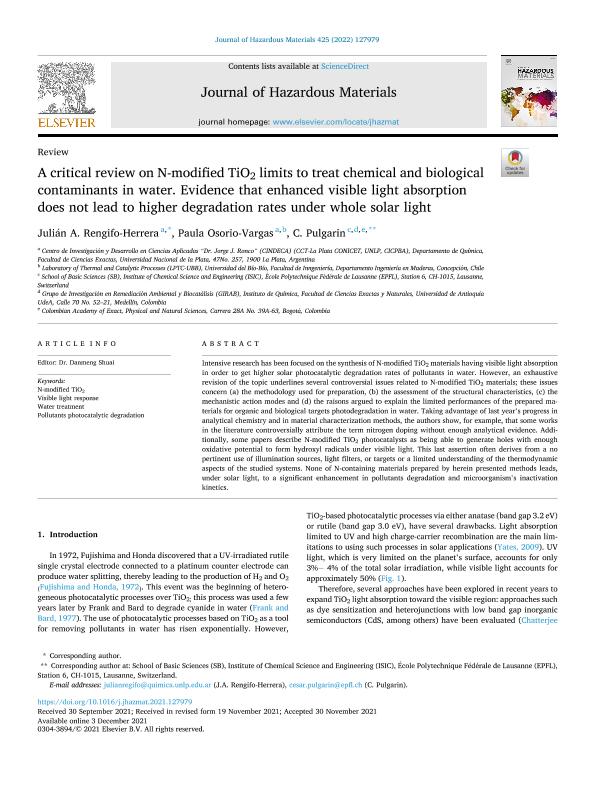Artículo
A critical review on N-modified TiO2 limits to treat chemical and biological contaminants in water. Evidence that enhanced visible light absorption does not lead to higher degradation rates under whole solar light
Fecha de publicación:
03/12/2021
Editorial:
Elsevier Science
Revista:
Journal of Hazardous Materials
ISSN:
0304-3894
Idioma:
Inglés
Tipo de recurso:
Artículo publicado
Clasificación temática:
Resumen
Intensive research has been focused on the synthesis of N-modified TiO2 materials having visible light absorption in order to get higher solar photocatalytic degradation rates of pollutants in water. However, an exhaustive revision of the topic underlines several controversial issues related to N-modified TiO2 materials; these issues concern (a) the methodology used for preparation, (b) the assessment of the structural characteristics, (c) the mechanistic action modes and (d) the raisons argued to explain the limited performances of the prepared materials for organic and biological targets photodegradation in water. Taking advantage of last year's progress in analytical chemistry and in material characterization methods, the authors show, for example, that some works in the literature controversially attribute the term nitrogen doping without enough analytical evidence. Additionally, some papers describe N-modified TiO2 photocatalysts as being able to generate holes with enough oxidative potential to form hydroxyl radicals under visible light. This last assertion often derives from a no pertinent use of illumination sources, light filters, or targets or a limited understanding of the thermodynamic aspects of the studied systems. None of N-containing materials prepared by herein presented methods leads, under solar light, to a significant enhancement in pollutants degradation and microorganism's inactivation kinetics.
Archivos asociados
Licencia
Identificadores
Colecciones
Articulos(CINDECA)
Articulos de CENTRO DE INV EN CS.APLICADAS "DR.JORGE J.RONCO"
Articulos de CENTRO DE INV EN CS.APLICADAS "DR.JORGE J.RONCO"
Citación
Rengifo Herrera, Julian Andres; Osorio Vargas, Paula Alejandra; Pulgarin, Cesar; A critical review on N-modified TiO2 limits to treat chemical and biological contaminants in water. Evidence that enhanced visible light absorption does not lead to higher degradation rates under whole solar light; Elsevier Science; Journal of Hazardous Materials; 425; 3-12-2021; 1-23
Compartir
Altmétricas




